
Coin with a Head of Apollo (detail), 410–403 B.C., Sikeliote (Sicilian Greek), minted in Katane. Silver tetradrachm signed by Choirion, 1 1/16 in. diam. Courtesy of the Museo Archeologico Regionale Paolo Orsi, Syracuse. By permission of the Regione Sciliana, Assessorato dei Beni Culturali e dell’Identità Siciliana. Dipartimento dei Beni Culturali e dell’Identità Siciliana. Unauthorized reproduction prohibited
Coins, whether ancient or modern, are invariably small and usually highly detailed. We have about 60 coins on display in the exhibition Sicily: Art and Invention between Greece and Rome, and they range in diameter from about ½” to about 1 ½”.
Despite their diminutive size, these coins play a large role in our telling the history of Sicilian culture from the 5th to the 3rd centuries B.C. Look closely, and you’ll observe several distinctively Sicilian innovations in coinage: Heads cast in three-quarter or frontal perspective, versus the traditionally flat profile view. Added signatures of the engravers (most ancient coins were designed anonymously). Scenes of chariot racing rendered with startling realism.
As the designer of this exhibition, I had to devise a way to put all these coins on display, so visitors could see and appreciate these important details. But coins present a number of unique challenges to the exhibition designer. Most other types of artwork have a “natural” method of display: paintings and photographs hang on the wall; sculptures sit on a pedestal; porcelain vases rest on a table or shelf. So what’s the “natural” way to display a coin? Placing it inside a pocket or purse might be the most authentic choice, but not the most viewer-friendly. A marble pedestal or gilt-wood frame might, on the other hand, be too exalted a setting for an object originally intended as an everyday medium of exchange.
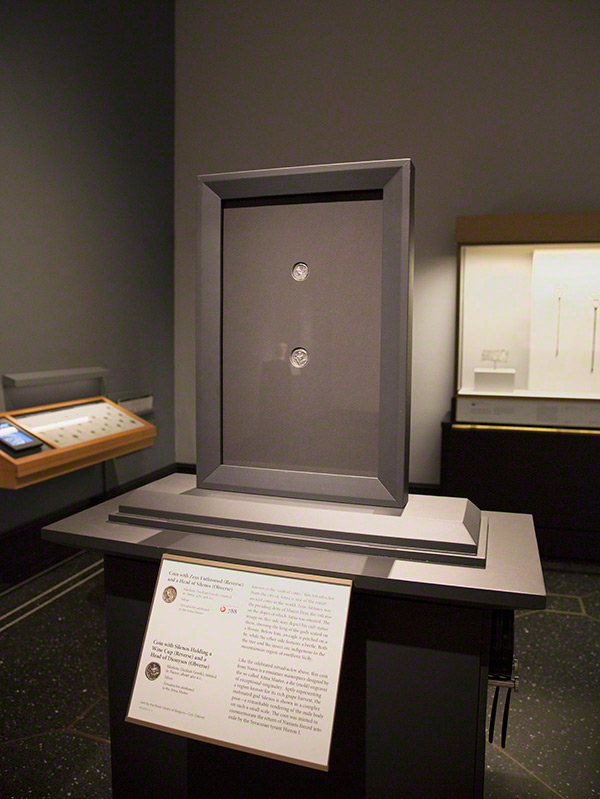
This double-sided frame allows visitors to see both sides of these two especially beautiful and rare coins, selected by our curators from about 60 total coins on view in this exhibit. Top: Coin with Zeus Enthroned (Reverse) and a Head of Silenos (Obverse), 476–461 B.C., Sikeliote (Sicilian Greek), minted in Aitna. Silver tetradrachm attributed to the Aitna Master, 1 1/16 in. diam. Bottom: Coin with Silenos (Reverse) and a Head of Dionysos (Obverse), about 460 B.C., Sikeliote (Sicilian Greek), minted in Naxos. Silver tetradrachm attributed to the Aitna Master, 1 1/8 in. diam. Both coins: Royal Library of Belgium—Coin Cabinet
These ancient coins pose further challenges, simply as three-dimensional objects that require a physical housing. Unlike modern coins, their shape is irregular: vaguely circular, with imperfections along the circumference created during their minting. If placed on a table, these coins would not rest flat on their side, due to the high relief of the engravings. Though we may try, the laws of physics prevent us from viewing both sides of a coin at once. (Some museums employ mirrors to circumvent this inconvenient fact.) Even if it were possible, the two sides of ancient coins almost never align by orientation. (That is, a coin showing the right-side-up view on one side will be upside-down or askew on the other side.) In short, ancient coins almost seem purposely designed to make life difficult for us exhibition designers.

Engraved on the obverse of each of these two coins are scenes of victorious athletes: a four-horse charioteer on the left, and a mule-cart driver on the right. Left: Coin with Nike Driving a Four-Horse Chariot (Obverse), 415–406 B.C., Sikeliote (Sicilian Greek), minted in Akragas. Silver tetradrachm, 1 3/16 in diam. Right: Coin with a Mule Cart (Obverse), 420–413 B.C., Sikeliote (Sicilian Greek). Silver tetradrachm, 1 in. diam. Both coins: Royal Library of Belgium—Coin Cabinet

Note how this coin, when viewed upright on the obverse (left), is askew on the reverse (right). Coin with Nike Driving a Four-Horse Chariot (Obverse) and Eagles Devouring a Hare (Reverse), Sikeliote (Sicilian Greek), minted in Akragas, 415–406 B.C. Silver tetradrachm, 1 3/16 in. diam. Royal Library of Belgium—Coin Cabinet
Coins also come with their own terminology, beginning with the word for the collecting and study of coins: numismatics. In any Getty exhibition, our labels and wall texts are usually written in plain-speak, to be understood by laypeople like myself. But no numismatist worth a kopek would use the words “front” and “back” to describe the two sides of a coin; it’s “obverse” and “reverse,” if you please. Our goal, then, was to use such terms when necessary, with visual clues that help visitors understand their meaning.
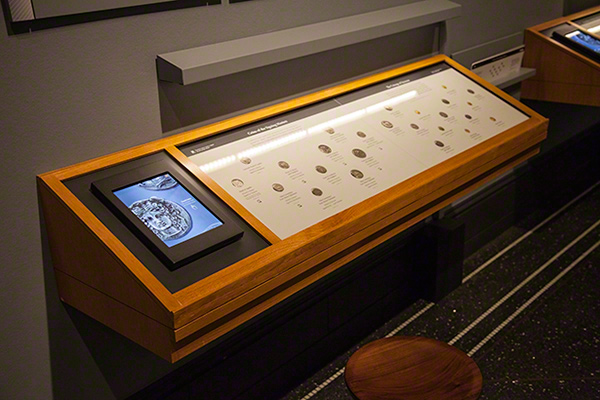

Most of the 60 or so coins in the exhibition are installed in these two angled cases. Selected coins in each case can also be viewed up close in brilliant retina display on adjacent iPads. All coins but one, both cases: Royal Library of Belgium—Coin Cabinet
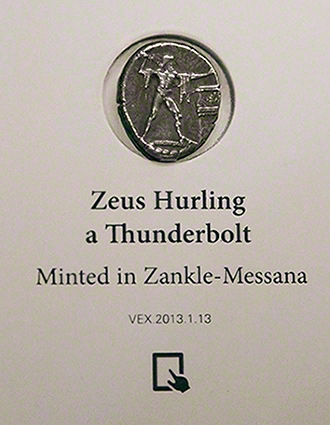
Coin with Zeus Hurling a Thunderbolt, 461 B.C., Sikeliote (Sicilian Greek), minted in Zankle-Messana. Silver tetradrachm, 1 1/8 x 15/16 in. Shown as installed in the cases above, at roughly actual size. Royal Library of Belgium—Coin Cabinet
So these are the design challenges we had to face before placing these 60 coins on view. It would take at least five or six posts to explain all the various solutions we employed! I haven’t even addressed the anti-theft measures or the controlled microclimates these coins require. Instead, I encourage you simply to visit Sicily: Art and Invention between Greece and Rome. If I’ve done my job well, all you should notice is the artistry and ingenuity of the coins themselves.
The exhibition Sicily: Art and Invention between Greece and Rome has been co-organized by the J. Paul Getty Museum, the Cleveland Museum of Art, and the Assessorato dei Beni Culturali e dell’Identità Siciliana. It celebrates 2013 as the Year of Italian Culture in the United States, an initiative of the Italian Ministry of Foreign Affairs, realized under the leadership of the President of the Republic of Italy.
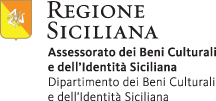

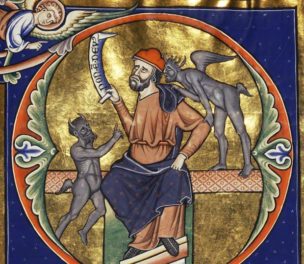
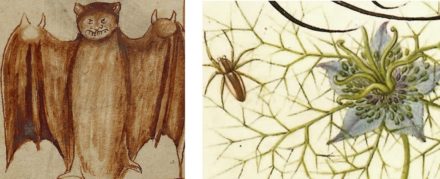

My compliments to Elie Glyn for the beautiful presentation of these coins.
I would like to visit the museum. How & do we need reservations?
Hello Marie! Admission to the Getty Villa is always free and an advance, timed-entry ticket is required. Tickets can be reserved by clicking the orange button that says “Get free tickets to the Getty Villa” on this page: http://www.getty.edu/visit/ . Hours are 10 A.M. to 5 P.M. every day except Tuesday.
Parking is $15 and the address of the Getty Villa is:
17985 Pacific Coast Highway
Pacific Palisades, California 90272
Looking forward to your visit!
Great article, will hopefully get over to visit the museum at some stage.
Coins can indeed tell a lot of history: They communicate a very short story by text and picture, and they can be dated well, which is important, too. Recently I stumbled upon the fact that the Dolphins on Syracusean coins show that there was a cult of Poseidon, there, which is not so obvious from other sources. Also the chariots could show bronze chariots, lost today, Syracuse was a very rich city. Cf. Gunnar Rudberg: Atlantis and Syracuse.
When I saw the show last week, the iPad displays on each case were reversed, with the coins referenced in case A being displayed on the iPad attached to case B and vice versa.
I have a Sicilly coin that has x, or cross in the back with a horse and two riders in front. Who can tell me if its worth keeping?
Hello Elie, great article, thanks for sharing.
I’d like to know which software did you use for showing the coins with the ipads .
and if it is possible to find it somewhere for using it for a coin exhibition we are planing to do.
thanks!
felipe